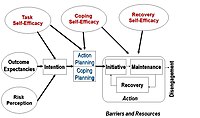
Photo from wikipedia
BACKGROUND AND AIMS Individuals of lower socioeconomic status (SES) display a higher prevalence of smoking and have more difficulty quitting than higher SES groups. The current study investigates whether the… Click to show full abstract
BACKGROUND AND AIMS Individuals of lower socioeconomic status (SES) display a higher prevalence of smoking and have more difficulty quitting than higher SES groups. The current study investigates whether the within-person associations of key risk (e.g., stress) and protective (self-efficacy) factors with smoking lapse varies by facets of SES. DESIGN AND SETTING Observational study using ecological momentary assessment to collect data for a 28-day period following a smoking quit attempt. Multilevel mixed models (i.e., generalized linear mixed models) examined cross-level interactions between lapse risk and protective factors and indicators of SES on smoking lapse. PARTICIPANTS A diverse sample of 330 adult U.S. smokers who completed a larger study examining the effects of race/ethnicity and social/environmental influences on smoking cessation. MEASUREMENTS Risk factors: momentary urge, negative affect, stress; Protective factors: positive affect, motivation, abstinence self-efficacy; SES measures: baseline measures of income and financial strain; Primary outcome: self-reported lapse. FINDINGS Participants provided 43,297 post-quit observations. Mixed models suggested that income and financial strain moderated the effect of some risk factors on smoking lapse. The within-person association of negative (odds ratio [OR] = 0.967, 95% [0.945, 0.990], p<.01) and positive affect (OR = 1.023, 95% confidence interval [CI] [1.003, 1.044], p<.05), and abstinence self-efficacy (OR = 1.020, 95% CI [1.003, 1.038], p<.05) on lapse varied with financial strain. The within-person association of negative affect (OR = 1.005, 95% CI [1.002, 1.008], p<.01), motivation (OR = 0.995, 95% CI [0.991, 0.999], p<.05), and abstinence self-efficacy (OR = 0.996, 95% CI [0.993, 0.999], p<.01) on lapse varied by income. The positive association of negative affect with lapse was stronger among individuals with higher income and lower financial strain. The negative association between positive affect and abstinence self-efficacy with lapse was stronger among individuals with lower financial strain, and the negative association between motivation and abstinence self-efficacy with lapse was stronger among those with higher income. The data were insensitive to detect statistically significant moderating effects of income and financial strain on the association of urge or stress with lapse. CONCLUSION Some risk factors (e.g. momentary negative affect) exert a weaker influence on smoking lapse among lower compared to higher socioeconomic status groups.
Journal Title: Addiction
Year Published: 2022
Link to full text (if available)
Share on Social Media: Sign Up to like & get
recommendations!